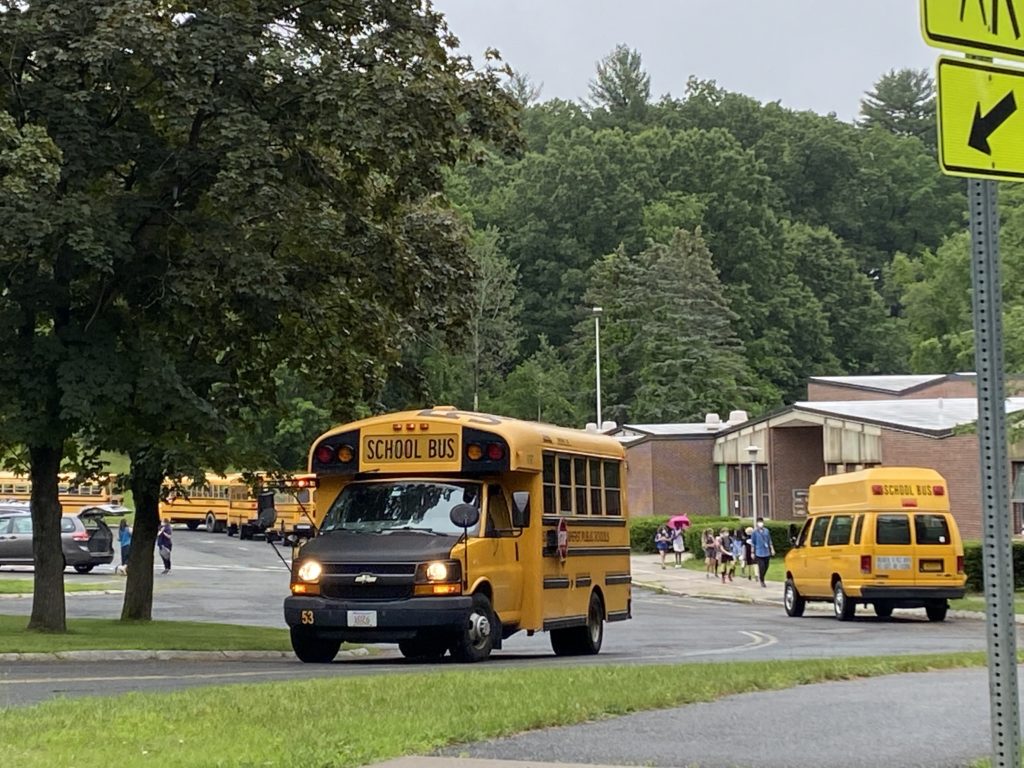Opinion: Jennifer Shiao’s School Committee Blog. Where Are We With The Elementary School Building Project?

Wildwood School bus departure. Photo: Toni Cunningham

Editor’s note: The Indy will now post Jennifer Shiao’s School Committee Blog as new entries become available. Shiao’s original posts can be found here. An archive of her blog posts in The Indy can be found here.
February 22, 2022 Amherst School Committee Meeting
I’ve mentioned in a previous post that the MSBA (Massachusetts School Building Authority) is like the bank in our elementary school building project. They will partially fund the project, and as the funder they require information and documentation about our project, as part of their process of working with school districts. The next step in the process for us is to submit the “Preliminary Design Program” (PDP) to the MSBA. Two important elements of the PDP are the educational plan and the space summary.
The educational plan is a document that describes how we deliver elementary education in Amherst, and what building elements are necessary to fulfill our needs. This document is 35 pages, and can be found on the BoardDocs page for the February 22 meeting (it is called 22-02-17 Ed Plan_DRAFT.pdf). The educational plan feeds the space summary, which is a giant spreadsheet that can be downloaded from the same page (22-02-17 FRES reduced program areas options (1).xls).
The February 22 meeting was largely devoted to going through the space summary section by section, with School Committee members asking questions and offering suggestions to the superintendent and the lead architect. Other members of the administration also attended the meeting to answer questions. We talked about things like the size of classrooms, the size and number of “project areas” rooms, the size and number of staff offices, the size of specialty rooms such as occupational/physical therapy rooms, the size of the gym, the size of the cafeteria, etc. It was all very detail-oriented, and rather tedious, but super important!
At the beginning of the meeting we heard and read public comments about the project. Here are the things I took away from the various comments we received, and the things I kept in mind when considering all the details about space in the building project:
- In order for this project to move forward to completion, Amherst voters will have to vote in favor of raising our property taxes for 30 years, via a debt-exclusion override*, to pay for the town’s portion of the building. Living in Amherst is already out of reach for many people, and current residents are finding it harder to afford living here. When we ask people to vote on raising their taxes, we need to be able to tell them that the amount that we’re spending on the building is not more than what we need in order to be able to deliver quality education to our students. As one commenter wrote, “We must ensure now, before we are locked in, that the size of the building is no bigger than absolutely necessary and uses all space extremely wisely.”
- This will be the first major town project to be completed under the net-zero bylaw. All other things being equal, a net-zero project costs more than a non-net-zero project. Our community has decided that fighting climate change via net-zero buildings is something that we value, therefore we must be willing to balance other needs in order to achieve net-zero. As another commenter wrote, “We don’t want to jeopardize the new school and our first net zero project by sticker shock due to an unnecessarily large new school building. There would also be a temptation for some to blame the net zero bylaw for the sticker price, which could undermine public support for the bylaw, one of the town’s essential efforts to fight climate change.”
I’m not an educator, nor an architect. I don’t have any expertise when it comes to how many square feet a break-out room or counselor’s office should be. I see my responsibility as representing the public and the school community, to deliver a project that people can support. I almost wrote “deliver a project that everyone can support” in that previous sentence, but I don’t believe in platitudes, and I don’t expect the debt-exclusion override to pass with 100% in favor. In fact, it only needs 50% + 1 voters in order to pass. But, I would love to see it pass with 60%, 65%, 70% in favor!
My overall feedback to Mike (superintendent) and Donna Dinisco (lead architect) on the space summary was: It would be great if we could get the building size down from the current/latest proposal of 105,750 square feet to around 100,000. AND we should focus on prioritizing space for students, and where reductions need to be made we should look to reduce individual/dedicated space for adults.
I’m hopeful that Dinisco and team will be able to take in the feedback from the other School Committee members and me, and come back on March 8 with a right-sized building. We will also be presented with cost estimates for the first time at that meeting. And we will need to vote our approval on the educational plan and space summary at that March 8 meeting.
Stay tuned! This is a very exciting time for this building project!
Here is a useful article that explains what a debt-exclusion override is.
This blog reflects my own views about the Amherst and Amherst-Pelham Regional School Committees – it does not represent the view of the committees, the district, or the superintendent. This blog complies with Open Meeting Law, as long as a quorum of School Committee members do not engage in deliberations in the comments. Comments are welcomed; commenters must register with their name and email address (email address will not be published). I may respond to comments, but I will not respond to all comments. Sign up here using the “follow blog via email” form to be notified when I post a new entry. You can email me at jennifer@jenniferamherst.org.

What seems odd or backward to me is that this process doesn’t start with a budget: how much can Amherst afford to pay for a renovated or rebuilt Fort River School. Then the design decisions flow from that amount. Not what do we want and then, oh how much does it cost? Isn’t this what happened last time? And this time we have 3 other building project to finance–and much long deferred maintance, such as millions for the high school track and a new artificial turf field.
We need to focus on needs, not wants. Kids need great teachers, a strong, deep curriculum, arts, music, sports, woodshop, etc…..adequate buildings. It’s what goes on inside the buildings that matters most.
Is the school committee going to see the cost for the first time on March 8th and vote the building plan at the same meeting? Seems like too many carts before the horse–with maybe the horse being Amherst taxpayers’ ability to pay.